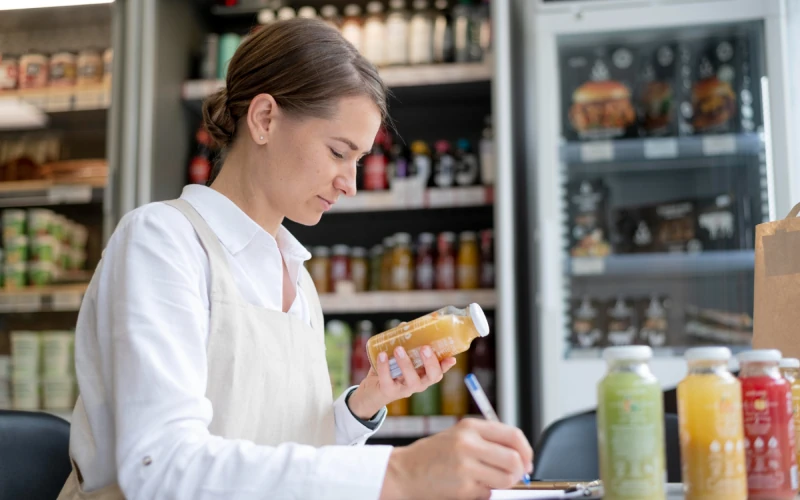Restaurant Inventory Management: Tools and Templates
September 23, 2024
Inventory management is one of the key areas to be aware of when running any kind of restaurant or bar business. Supplying enough stock to satisfy your customers while not ordering too much can cause a major waste of products and as a result, escalate your associated costs. This is why restaurant owners and managers have to keep themselves updated and try to be equipped with tools that make it easier for them to manage their businesses – whether that's a restaurant inventory sheet PDF, a restaurant inventory spreadsheet, or a complete restaurant inventory system.

In this guide, we will go into everything you need to know about restaurant inventory management, and provide you with useful templates like the restaurant bar inventory spreadsheet and the restaurant equipment inventory list template and a restaurant food inventory list to help you manage your operations.
Why Restaurant Inventory Management Matters
Restaurant inventory management is about tracking your stock of food, beer, wine and any other supplies in your restaurant, and what you need to keep your restaurant up and running. Knowing what you have, what you need, and when you need it can help your bottom line by keeping food waste and unnecessary expenses to a minimum, and turnover down.
Here are the main reasons why restaurant inventory management is critical:
-
Cost Control
Accurate tracking will prevent overordering and waste. It will allow you to understand your true food costs and where you need to improve. -
Avoid Stockouts
If you run out of an ingredient in the busy rush of dinner service time, your reputation can take a hit and you can lose sales. -
Waste Reduction
This way, you would always know how much of each product you have left and, therefore, prevent food waste and make sure that all ingredients are fresh. -
Improve Supplier Relationships
There is nothing better for improving a relationship with your suppliers than ordering on a regular basis and paying on time. Often, more favorable pricing and terms will follow.
The Challenge of Manual Inventory Tracking
For restaurants, inventory is a vital part of the business. While many still use tools such as pen and paper or a basic spreadsheet to track inventory, these tools are simple to use but prone to errors. Manual counting or forgetting to log items can lead to problems with stock (aka food), which can impact your day-to-day operations.
If your restaurant is small, a restaurant inventory sheet PDF might be enough for you, but if you see the growth of your business in the future, be ready to get advanced systems, such as a restaurant inventory system, or a custom restaurant bar inventory spreadsheet.
Essential Restaurant Inventory Tools
To keep your inventory effective, you should have tools that track your stocks, forecast, and replenish as well. Below are the essential tools every restaurant owner or manager should have.

1. Restaurant Inventory Sheet PDF
This is a restaurant inventory sheet PDF that is suited for small restaurants or for someone just starting out. This is a simple, easy-to-use tool that can be printed and then manually filled in for your inventory. Columns include an item, unit of measure, quantity on hand, and reorder point.
These are fine for a quick tally, but they are not ideal for big restaurants or bars with a significant volume of product. While it is handy, stuff happens with manual entries. If you are a startup with a low-tech approach, this could be an option for you, but it is not scalable.
2. Restaurant Inventory Spreadsheet
For restaurants looking for a bit more flexibility, a restaurant inventory spreadsheet is a step up from pen and paper. A good spreadsheet should allow you to calculate food costs, track supplier orders and stock levels, all in real-time.
Lots of free templates are available online to use, or you can create your very own restaurant food inventory list in Excel or Google Sheets. Using an Excel or Google Sheets spreadsheet to hand-enter data is nice, as you can still do the calculations yourself and type out your own alerts, but you won't ever have to worry about adding up columns by hand, and you can also look at your data in a number of different ways to get a greater insight into how you're using your stock, and why you're ordering as much as you are, and when you're ordering it.
Here's what an efficient restaurant inventory spreadsheet should include:
-
Item name
Clearly identify the item in stock (e.g., chicken breasts, lettuce, or red wine). -
Category
Group items by category, such as perishables, dry goods, beverages, or supplies. -
Unit of measurement
Specify how each item is measured (e.g., pounds, liters, cases). -
Par levels
Define your optimal stock levels to prevent under or overstocking. -
Quantity on hand
Track the exact amount of each item in stock. -
Reorder point
Determine when you need to reorder each item. -
Price per unit
Record the cost per unit to calculate the total value of your inventory.
With such a spreadsheet, you can set up your own restaurant inventory and adjust it to your needs (and build in formulas to update entries automatically when you change quantities or costs, but that's another article…).
3. Restaurant Bar Inventory Spreadsheet
Bars require a special type of inventory as many of the items they sell are perishable and others are not. A restaurant bar inventory spreadsheet will help you keep track of liquor, beer, wine and mixers. This can make or break the business for you, as you may avoid stocking out on fast-moving items and at the same time not stock out on slow-moving products.
Important elements to include in a bar inventory spreadsheet:
-
Brand and type
Include details about the alcohol or mixers (e.g., Jack Daniel's, Chardonnay). -
Size
Specify the bottle or container size (e.g., 750 ml, 1 liter). -
Initial stock
Start each period with the quantity of each product you have. -
Stock used
Track how much was used over a given period (weekly or monthly). -
Ending stock
The figures remaining in stock at the end of each period help you answer two essential questions. Firstly, do you sell enough to be profitable? Secondly, what drinks are very popular that you should keep stocked?
4. Restaurant Equipment Inventory List Template
Along with food and beverages, the functioning of a restaurant depends on other things as well. For instance, a restaurant needs equipment such as an oven, mixer, freezer and so on and these need regular maintenance and at times replacement.
A restaurant equipment inventory list template will help you track:
-
Equipment name
Include the specific name and type of equipment (e.g., convection oven, blender). -
Purchase date
Record the date of purchase to track equipment lifespan. -
Maintenance schedule
Ensure regular maintenance by noting the next service date. -
Cost
Include the purchase price and a replacement cost estimate for budget purposes. If you keep your restaurant equipment inventory list up to date, then you're less likely to experience costly breakdowns. You'll also know what equipment to retire before it fails and whether it's time to consider upgrades or replacements.
5. Restaurant Food Inventory List
The restaurant food inventory list is the hub of your stock control system: recording the raw goods that go into all the dishes on your menu. It is crucial that you update it regularly so that you can keep your food costs under control, reduce your wastage and maximize your profits.
Some key features of a good restaurant food inventory list include:
-
Ingredient name
List all the ingredients you use, from spices to proteins. -
Quantity on hand
Record the exact amounts of each ingredient available. -
Supplier information
Keep track of where each ingredient comes from for easy reordering. -
Expiration date
Monitor expiration dates to avoid waste and ensure food safety. -
Unit cost
Knowing the cost of each ingredient helps calculate overall food costs and profitability.
Secondly, restaurants can avoid spoilage and over-stocking by keeping track of their food, which should help you better manage supply and demand.
Modern Restaurant Inventory Systems
Fresh dining establishments might find spreadsheets and manual inventory-keeping methods to be adequate, but once your restaurant starts growing, these can rapidly become more and more cumbersome. A restaurant inventory system is probably in order at this point. A digital system automates inventory management, allows for real-time tracking and frequently integrates with your POS system to enable easy to manage the process.
Some features of a good restaurant inventory system include:
-
Real-time updates
Automatic updates when inventory is used or restocked. -
Analytics
Detailed reports on stock usage, shrinkage, and trends. -
Supplier integration
Easy reordering directly from suppliers when stock reaches a critical level. -
Cost control
Detailed insights into food costs and profitability. -
Multi-location support
Perfect for businesses with more than one outlet so you can manage your inventory across multiple locations.
Often these systems also come with mobile apps, so that your employees can perform inventory counts on their phones or tablets, bypassing manual data entry altogether.
Conclusion
Efficient restaurant inventory management is key to any foodservice business, whether it's maintaining your restaurant inventory sheet PDF, using a restaurant inventory spreadsheet or looking for a more advanced restaurant inventory system. It helps to keep stock levels optimal, reduce waste and ultimately make the business more profitable.
Review your current inventory procedures and practices and identify your shortcomings. Then try out one or more of the very best tools including the restaurant food inventory list and restaurant equipment inventory list template. Your restaurant could flourish or suffer, and you could be the prime determiner.
